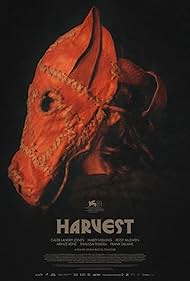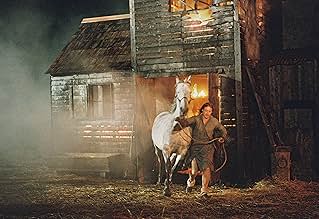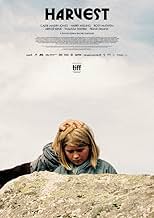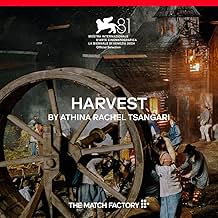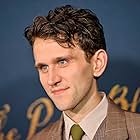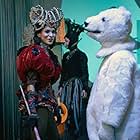Over seven hallucinatory days, a village with no name, in an undefined time and place, disappears.Over seven hallucinatory days, a village with no name, in an undefined time and place, disappears.Over seven hallucinatory days, a village with no name, in an undefined time and place, disappears.
- Awards
- 3 nominations
- Director
- Writers
- All cast & crew
- Production, box office & more at IMDbPro
Storyline
Featured review
Harvest (2024), based on the novel with the same name by Jim Crace (2013), is a film directed by Athina Rachel Tsangari about a remote English village as economic progress disrupts their peaceful life following the "Inclosure acts". The opening shots introduce the protagonist, Walter Thirsk (played by Caleb Landry Jones), running through fields, playing with bugs and swimming in a lake, In other words, he's basking in nature and has some sort of spiritual moment (we later find out he was eating 'shrooms but it doesn't matter much to the plot).
Later we see a scene in a nearby village where people are trying to extinguish a fire, In this village we see the rest of the "action" (there's not much of it) in the movie. They have a master by the name of Kent (played by Harry Melling - Neville Longbottom in Harry Potter) who hires a chart maker, Phillip Earle, to map out the village. Walter (the main character) picks up an injury on his hand during the fire so he can't plough the land or help much with manual labour. Thus he becomes a de facto assistant to Phillip (the chart maker).
Oh, there's also some intruders to their land at one point, two men and a woman who cause a fight with the villagers. In a semi-comical way (probably intentional), the villagers hold the two men hostage and shave the woman's hair as punishment. The men stay as prisoners for about a week, while the woman runs away. The role of these characters, beside representing "the others" against which the villagers would (sort of) unite in a heavy-handed xenophobic way, doesn't amount to much. The rest of the story pans out in this simmering heat. I can't call it real tension because almost at no point in the movie did I really care about any of the characters. That could be my fault, but I surely wasn't helped along the way. If the director's intention was to portray a village that is on its way to disappear, she succeeded, just too early in the story for us to care.
Without spoiling much, some stuff happens later on, and if there's something that united the two main characters, Walter and Kent, it's their permanent disengagement with what is happening around them. It's a weird (and bold move) to tell a story through characters that are extremely passive, and it could work in theory, if the action around them is interesting enough, but it just painfully lacks any real tension.
I can't speak of the novel, as I haven't read it, but I did watch the film and here's how I would describe it in short: a confused tale about a village struggling for its existence with a main protagonist that just doesn't seem to care (and doesn't make us care either); all that is shot in a beautiful 16mm film that creates an eerie ambience that instead of providing clarity to the plot just muddies it even more.
Or if you prefer the official synopsis, "Over seven hallucinatory days, a village with no name, in an undefined time and place, disappears".
When it comes to aesthetics, it is undoubtedly a beautiful film. But as is often the case, the director falls in love with the form rather than the substance, and if in a novel that can work, film is a different medium and rarely does it satisfy audiences by self-indulging without giving anything substantial in return.
I can read and enjoy someone like Joyce or Proust obsess over textures, senses and feelings, but it's asking too much from the audience to create those descriptions in our heads out of beautiful shots in a film and at the same time remain engaged in the story, without providing at least some psychological nuance (if not action). The eeriness and dreamlike mood that it clearly goes for makes the film watchable, it's just not enough to keep me engaged in the characters and the plot itself. The confusion of the protagonist seeps through to the audience, and the story... well, we're never quite sure what to make of it.
Later we see a scene in a nearby village where people are trying to extinguish a fire, In this village we see the rest of the "action" (there's not much of it) in the movie. They have a master by the name of Kent (played by Harry Melling - Neville Longbottom in Harry Potter) who hires a chart maker, Phillip Earle, to map out the village. Walter (the main character) picks up an injury on his hand during the fire so he can't plough the land or help much with manual labour. Thus he becomes a de facto assistant to Phillip (the chart maker).
Oh, there's also some intruders to their land at one point, two men and a woman who cause a fight with the villagers. In a semi-comical way (probably intentional), the villagers hold the two men hostage and shave the woman's hair as punishment. The men stay as prisoners for about a week, while the woman runs away. The role of these characters, beside representing "the others" against which the villagers would (sort of) unite in a heavy-handed xenophobic way, doesn't amount to much. The rest of the story pans out in this simmering heat. I can't call it real tension because almost at no point in the movie did I really care about any of the characters. That could be my fault, but I surely wasn't helped along the way. If the director's intention was to portray a village that is on its way to disappear, she succeeded, just too early in the story for us to care.
Without spoiling much, some stuff happens later on, and if there's something that united the two main characters, Walter and Kent, it's their permanent disengagement with what is happening around them. It's a weird (and bold move) to tell a story through characters that are extremely passive, and it could work in theory, if the action around them is interesting enough, but it just painfully lacks any real tension.
I can't speak of the novel, as I haven't read it, but I did watch the film and here's how I would describe it in short: a confused tale about a village struggling for its existence with a main protagonist that just doesn't seem to care (and doesn't make us care either); all that is shot in a beautiful 16mm film that creates an eerie ambience that instead of providing clarity to the plot just muddies it even more.
Or if you prefer the official synopsis, "Over seven hallucinatory days, a village with no name, in an undefined time and place, disappears".
When it comes to aesthetics, it is undoubtedly a beautiful film. But as is often the case, the director falls in love with the form rather than the substance, and if in a novel that can work, film is a different medium and rarely does it satisfy audiences by self-indulging without giving anything substantial in return.
I can read and enjoy someone like Joyce or Proust obsess over textures, senses and feelings, but it's asking too much from the audience to create those descriptions in our heads out of beautiful shots in a film and at the same time remain engaged in the story, without providing at least some psychological nuance (if not action). The eeriness and dreamlike mood that it clearly goes for makes the film watchable, it's just not enough to keep me engaged in the characters and the plot itself. The confusion of the protagonist seeps through to the audience, and the story... well, we're never quite sure what to make of it.
- avasilachi
- Sep 12, 2024
- Permalink
Details
- Runtime2 hours 11 minutes
- Color
- Sound mix
- Aspect ratio
- 1.66 : 1
Contribute to this page
Suggest an edit or add missing content

